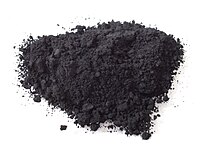
| |
| Names | |
|---|---|
Other names
| |
| Identifiers | |
3D model (JSmol)
|
|
| ECHA InfoCard | 100.014.191 |
| EC Number |
|
| E number | E152 (colours) |
| UNII | |
CompTox Dashboard (EPA)
|
|
| |
| Properties | |
| C | |
| Molar mass | 12.011 g·mol−1 |
| Appearance | Black solid |
| Density | 1.8–2.1 g/cm3 (20 °C)[1] |
| Practically insoluble[1] | |
| Hazards | |
| Lethal dose or concentration (LD, LC): | |
LD50 (median dose)
|
> 15400 mg/kg (oral rat)[1] 3000 mg/kg (dermal, rabbit)[1] |
Except where otherwise noted, data are given for materials in their standard state (at 25 °C [77 °F], 100 kPa).
| |

Carbon black (with subtypes acetylene black, channel black, furnace black, lamp black and thermal black) is a material produced by the incomplete combustion of coal tar, vegetable matter, or petroleum products, including fuel oil, fluid catalytic cracking tar, and ethylene cracking in a limited supply of air. Carbon black is a form of paracrystalline carbon that has a high surface-area-to-volume ratio, albeit lower than that of activated carbon. It is dissimilar to soot in its much higher surface-area-to-volume ratio and significantly lower (negligible and non-bioavailable) polycyclic aromatic hydrocarbon (PAH) content.
Carbon black is used as a colorant and reinforcing filler in tires and other rubber products; pigment and wear protection additive in plastics, paints, and ink pigment.[2] It is used in the EU as a food colorant when produced from vegetable matter (E153).
The current International Agency for Research on Cancer (IARC) evaluation is that, "Carbon black is possibly carcinogenic to humans (Group 2B)".[3] Short-term exposure to high concentrations of carbon black dust may produce discomfort to the upper respiratory tract through mechanical irritation.
- ^ a b c d Record in the GESTIS Substance Database of the Institute for Occupational Safety and Health
- ^ "Market Study: Carbon Black". Ceresana. Retrieved 2013-04-26.
- ^ Kuempel, Eileen D.; Sorahan, Tom (2010). "Identification of Research Needs to Resolve the Carcinogenicity of High-priority IARC Carcinogens" (PDF). Views and Expert Opinions of an IARC/NORA Expert Group Meeting, Lyon, France, 30 June – 2 July 2009. IARC Technical Publication No. 42. Lyon, France: International Agency for Research on Cancer. 42: 61–72. Archived from the original (PDF) on 4 March 2016. Retrieved August 30, 2012.